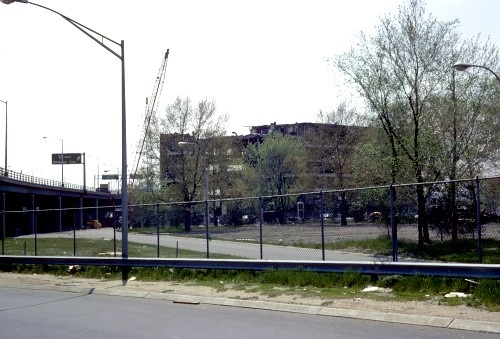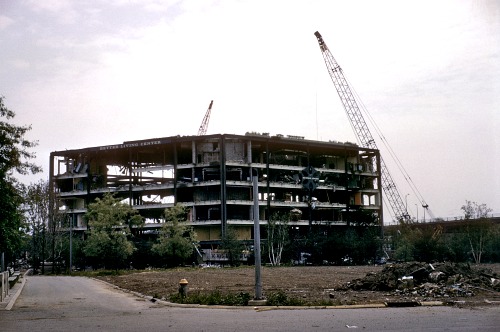|
PAVILIONS LISTED FOR FUTURE USES
Moses Suggests Demolition of Many
Noted Structures
By ROBERT ALDEN
|
|
Robert Moses yesterday made public his "tentative conclusions"
as to which World's Fair structures should be retained and which
should be demolished after the close of the fair.
Save for Philip Johnson's gaily colored carnival canopy of
the New York State Pavilion and, possibly, the United States
Pavilion, all of the structures on the fairgrounds that won architectural
praise are on the demolition list.
Among these are the Pavilion of Spain and the stone wall of
the Japanese Pavilion, which was called by one critic "perhaps
the most important piece of contemporary art" at the fair.
The failure to include the wall was a surprise. As late as
January, in the fair's report to its directors, the wall, the
work of the well-known Japanese sculptor Nagare, was singled
out as a structure that might be reconstructed elsewhere in the
post-fair park on the site as part of a Japanese garden.
Site for Records Suggested
In contrast, Mr. Moses added to the
list of buildings that might possibly be retained one that had
not been mentioned in the January report -- the Better Living
Center, a huge structure that had not found favor with architectural
critics. It was suggested that the center be used as a storage
hall for city records.
Mr. Moses listing of the structures for possible preservation
came as a result of the appointment by Mayor Wagner of William
F. Shea, Director of the Budget, as head of a committee to work
with the fair in selecting the buildings to be saved. The Mayor
acted so that Mr. Moses would not have a unilateral hand in making
the selections.
On Feb. 23rd Mr. Moses sent a letter to Mr. Shea making his
recommendations and
|
appointing John T. O'Neil, director of the fair's engineering
staff, as his representative on the committee. The letter was
made public yesterday.
In it Mr. Moses outlined some of the factors involved in suggesting
whether to retain a building, including the cost of converting
a building to a permanent structure and the possible uses to
which a building might be put.
Among the post-fair projects mentioned by Mr. Moses in his
letter was the conversion of Singer Bowl to a permanent site
for outdoor concerts. A spokesman for the Metropolitan Opera
Association said that it had an engineering study of the possibility
well underway and that the Met was considering using the bowl
in 1967 after Lewisohn Stadium is demolished.
In the January report, Mr. Moses had mentioned that the lower
portion of the Bell System's building might be retained. In the
letter, however, Mr. Moses recommended its demolition because
Bell was not willing to pay the $500,000 needed to adapt it.
Bell is obligated to pay the $350,000 demolition cost.
The demolition of the du Pont and Ford structures was also
recommended for similar reasons.
The Board of Education is interested in the United States
Pavilion for lectures and administration, but Mr. Moses said
that "whether the United States Government would contribute
substantially is doubtful."
The case of the Better Living Center
is somewhat different since its financial position is such that
its owners may not be able to fulfill their obligation to demolish
the structure. If they cannot, then the fair will have to assume
the costs of demolition -- unless the fair can convince the city
to undertake the cost of conversion to a record storage center.
|
|
SOURCE: The
New York Times, March 5, 1965
|
SOURCE: Excerpt
from Third Supplemental Report on New York World's Fair 1964
-1965 Corporation Covering Operations from Inception to December
31, 1966, Issued October 26, 1967
|
... The full amount owed [to the Fair Corporation] by the Better
Living Pavilion on December 31, 1965 was ... $516,299.33. Furthermore,
it appeared ... that the group in control of the concession would
also abandon its building and leave the demolition to the Fair
Corporation. The early estimates were that this would necessitate
an additional expenditure of $600,000.00 by the Fair for demolition.
On January 14, 1966, however, the Fair Corporation concluded
an agreement with Better Living Associates in which the latter
agreed to demolish its own structure and, in addition, to pay
the sum of $200,000.00 as settlement in full of its debt. The
$200,000.00 was thus received by the Fair and the difference
written off to the reserve for bad debts. |
|
While the Better Living
Center ultimately performed better than similar exhibition-style
halls like the Pavilion of American Interiors, it was still a
financial failure. By the close of the Fair losses were reported
in excess of $500,000 and the Fair was only able to recoup $200,000
of that from the Better Living Center's investors while absorbing
the balance (which only added to the debt problems the Fair Corporation
already faced). There had been some speculation prior to the
start of the 1965 season that the pavilion might be among those
retained after the Fair as a place to store records for the city.
Those plans never came to serious fruition as the city was not
about to budget the necessary costs to make such a post-Fair
use possible.
It is likely that the Better
Living Center's restrictive traffic flow was a major contributor
to its failure. Like it or not, the Fairgoer who wished to see
the American Masterpieces exhibit on the third floor was not
going to escape a look at demonstrations of massage chairs and
Schick's History of Shaving, and youngsters who would
have found the model train exhibit on the lobby level fascinating
had to filter their way through the women's fashion exhibits
on the upper floors before getting to see it. The Better Living
Center's promoters had designed their pavilion to the benefit
of their tenants -- to the detriment of their visitors. It "trapped"
the Fairgoer denying them a choice in what they would or would
not see. More often-than-not, this resulted in negative word-of-mouth
about the pavilion making potential visitors more inclined to
shy away from the Better Living Center and its exhibits than
to spend two hours forced to endure exhibits they really weren't
interested in seeing.
The failure of these kinds
of pavilions was perhaps something that should have been better
foreseen given the Fair's vast scope and the popularity of so
many other larger-than-life attractions in the Industrial and
Transportation sections. While the Better Living Center certainly
offered more variety than simple department store-like exhibits
and pitches, even its more diverse elements were not unique to
the pavilion. The General locomotive, which quite possibly
qualified as the most unique exhibit the Better Living
Center had to offer, was situated on the ground level outside
the building. A typical Fair visitor, especially male visitors
who would not have a natural interest in something like the Crystal
Palace Fashion Show, might think that he'd seen all he needed
to once he'd seen the Civil War locomotive and then would move
on to nearby General Electric or Kodak. "All About Elsie,"
despite the novelty of having a live animal fixed on-stage the
whole time, was really no different than similar puppet show
revues one could find in popular pavilions like those of Chrysler
and IBM. The Arnold Palmer Putting Course on the third floor
could by itself hardly measure up to the kind of game offerings
to be found in the Fair's Amusement Area.
What the Better Living
Center could have used most was a larger-than-life "grabber"
situated on its upper levels; something truly unique from a Fairgoing
perspective that would make its enforced traffic flow through
the rest of the building worthwhile. Perhaps if the American
Masterpieces exhibit had featured a very well-known, specific
American painting that the typical Fairgoer would find a "must"
to see, just as the Pieta was a "must" to see at the
Vatican Pavilion or if the "All About Elsie" show was
done with a Disney style Audio-Animatronic approach, more visitors
would have included the Better Living Center on their "must
see" list. In hindsight, the Better Living Center seems
more like a case of a pavilion that was geared too much toward
the style of a County Fair and, given the larger-than-life scope
that had been planned for the New York World's Fair from the
beginning, this was an approach that could never have succeeded
without injecting some new forward thinking into the mix.
-
Demolition
of the Better Living Center, 1966
SOURCE: Photos
presented courtesy Bill Cotter collection © 2010 Bill Cotter,
All Rights Reserved. See more images from Bill's fabulous
collection of World's Fair photographs at his website WorldsFairPhotos.com.
 |
 |
The failure of pavilions
like the Better Living Center should by no means make us lessen
their importance to the overall history of the 1964-1965 New
York World's Fair. Even if the exhibits inside were not especially
unique when one tallied up the things to be found over the rest
of the Fairgrounds, the Better Living Center did manage to serve
as a microcosm of how this was a World's Fair that tried to be
"Something for Everyone." New products from American
business and industry, appreciation for history, musical and
artistic creativity and simple amusement were things that could
be found in many corners of the Fair. The Better Living Center
was certainly the only place at the Fair that attempted to provide
a taste of all of that under one roof.
* * *
|
|
Webmaster's note... Once again, historian Eric Paddon provides
us with a fascinating look into one of the major exhibits of
the 1964-1965 New York World's Fair. What Eric doesn't tell you
in any of his insights on the various exhibits presented here
is that he has a very personal connection to the Better
Living Center. As you read through the commemorative Groundbreaking
Brochure you might catch the name of one of the participants
in the Groundbreaking Ceremony -- Mr. W. W. Paddon, President
of the Sunshine Biscuit Corporation, a major exhibitor in the
Better Living Center. Mr. Paddon was Eric's Grandfather!
Sadly, Eric could not find any memorabilia related to Sunshine's
participation in the Fair so if any visitors to this website
have anything related to Sunshine's participation, please let
me know and I will forward it to Eric and will include it in
the Feature. Thank you, Eric, for this wonderful addition to
nywf64.com.
and to the preservation of the memories of the Fair. My thanks
also go out to Bill Cotter for once again donating his beautiful
photographs of the Better Living Center - both inside and outside
- and for the contribution of his Better Living Center memoralia
to enhance this Feature. And, also to Craig Bavaro for his great
Publicity Shots from his collection of World's Fair Corporation
materials and to Mr. Bob Sivilic for his up-close photo of the
Lifesavers Tower!
Eric, thank you for your patience
with me to get this feature online. Eric put this material together
for me several years ago and he's waited a long, long time to
see it in public. Thank you again, Eric, for your research and
hard work on this presentation. It is much appreciated!
- Bill Young
- February, 2010
|
|